




Ahoy, down to the sea in ships again! Any chance we get to escape to parts unknown, and we can do it with Viking Cruise Lines, we jump (or swim) to get on board! While we had been to Norway several other times, we always greatly enjoyed the scenery and the culture so are not averse to another look. The other half of this voyage was to be spent on the Rhine River from Amsterdam to Basel. We had never taken a Rhine cruise before, so this sounded the perfect combination for us. The trip was advertised as Norwegian fjords and Rhine River castles. We booked it last year before the stock market began its decline, so it was already paid for. So naturally, we were off again.
1st Port of Call: Bergen, Norway
We landed at Bergen airport and were met by the Viking staff who whisked us off to the Viking Jupiter. Since we had already explored this city before and we were tired from the long flights, we were happy to be taken aboard right away.
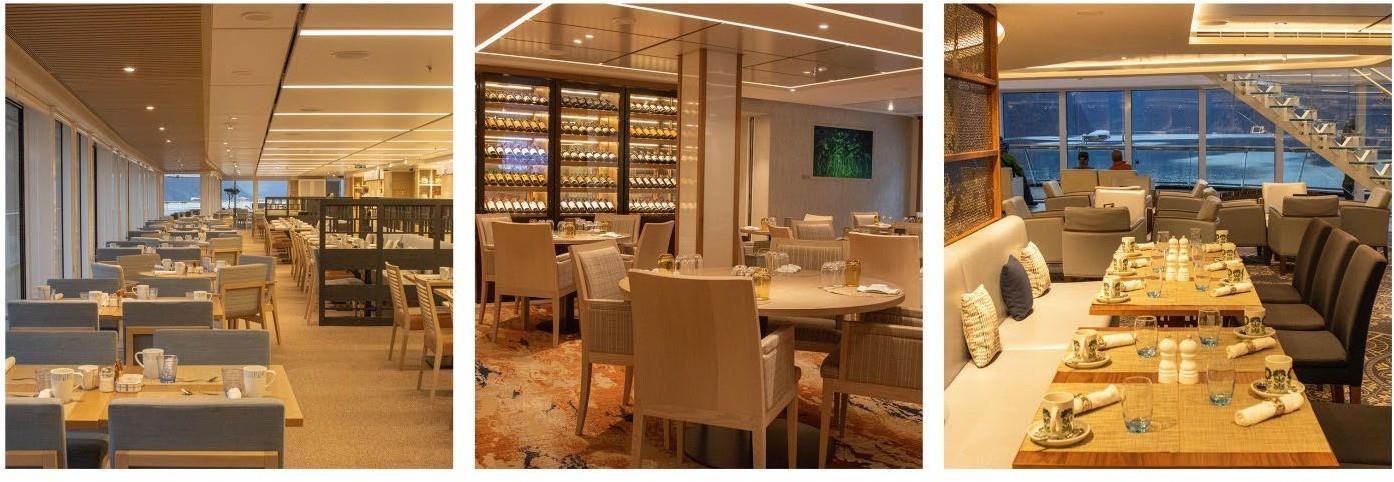
Since the Viking ocean-going fleet is comprised of ships with the same design and features, we did not have to spend any time familiarizing ourselves with where everything is located: our room, the restaurants, the bars, the spa, the theater, the explorers lounge, or the service desks. Hence, we went first to the World Café for our lunch and then to our own cabin where our luggage awaited unpacking.
2nd Port: Flam, Norway
In Norwegian, the very small town’s name translates to “Flat place in the Mountains.” In this part of Norway, there are very few flat spots where towns can be established and Flam (pronounced like it is spelled “Flum” in English), dates from 1530. Most of the time, the town has only 400 inhabitants, but during summer tourism season, the population swells significantly. Our visit did not occur in the high season, and we were the only visitors around. The scenery is the attraction as well as hiking, riding the Flam Railway up into the mountains above the city, and cruising the narrow Songe Fjord where the steep sides reach 6000 feet.

For an additional tourist attraction, the city has built the impressive Stegastein Viewpoint: the 100-foot wooden ramp extends 2000 ft above the Sogne Fjord, permitting panoramic views thru 360 degrees. The drive up to the viewpoint is impressive itself. There are so many switchbacks and hairpin turns to reach the area that your ears begin to pop, and the road is right on the edge of the very steep mountains. If prone to acrophobia or carsickness, this ride up is not for you.


On the way back down the mountain, we stopped at the county seat called Aurland and explored a bit. The most interesting thing in this larger town was the old, white-washed church dating from 1202, having been built by a Viking warlord in gratitude for his & his cohort’s escape from an enemy.
Unhappily, the church was not open for visitors, but we did explore the cemetery beside it. Many of the gravestones were so weathered as to be unreadable, but the oldest one we could decipher dated from 1576! That is impressive.
After those vertiginous experiences, we decided to walk around the small town to check out the coop grocery store, the tiny museum, the gift shops, bakeries and city park. We were still jet lagged and it seemed a clever idea to be on our feet awhile. It was a beautiful mountain day with deep blue skies, cool but not cold temperatures and lots of sunlight. A good start to the first part of the Norwegian section of this Viking voyage

This Southern port city is best noted for its “Gamle Stavanger”meaning “Old City.” Besides lots of cobblestone streets, Stavanger protects its 250 old wooden houses dating from the 18th and 19th centuries. At one time, the city fathers decided to destroy old town in favor of more modern facilities and residences. However, a great cry went up from the populace and a conservancy was formed to save “Gamle.” North Sea oil money helped in saving and repairing the many houses as well. Today, they are private homes which can be modernized on the inside but not altered in any way on the outside.
Strolling through this charming area of the city is like having a walk back in time. The houses are white but there are many colorful accents like flowerpots overflowing with blossoms and interesting small sculptures nestled in the front yard gardens. Behind the houses rose steep green hills adding to the beauty of the area. There were also lots of cats to merit photos, very pleasing to us.
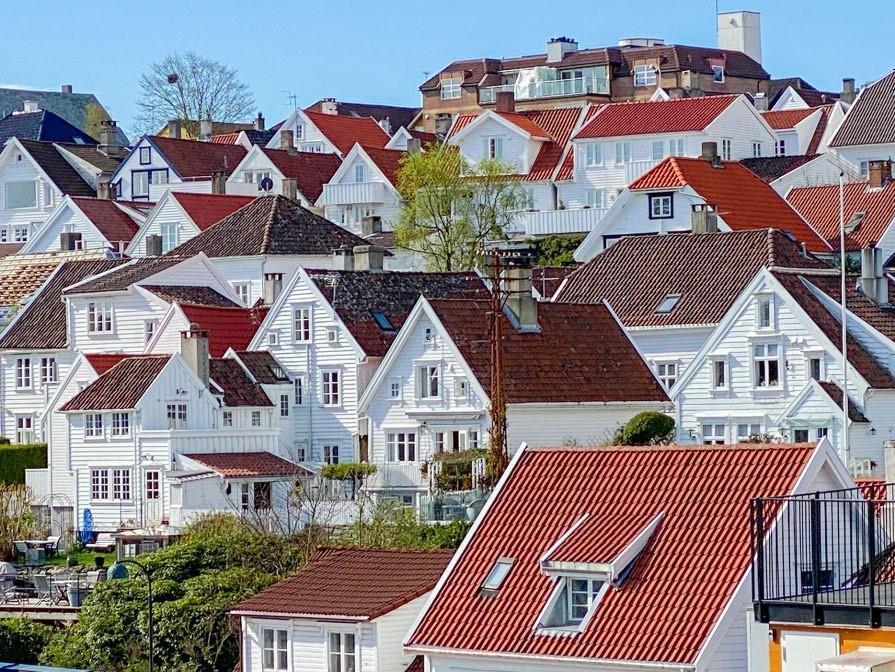
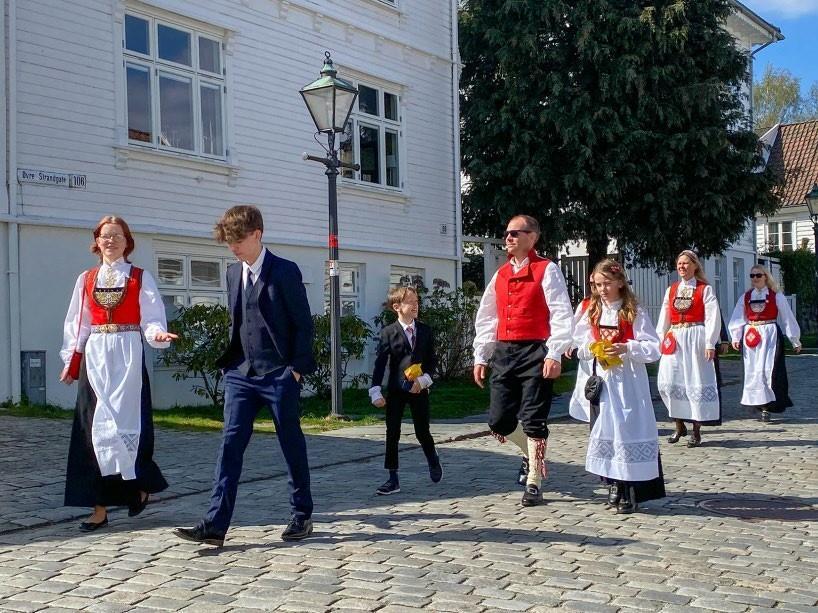
For us, the walks were doubly interesting because we got to observe people of all ages wearing traditional Norwegian dress as they went to weddings in local churches or for school graduations and other celebrations. The women’s and girls’ ensembles were bright and vibrant with colors too. Intricate and beautiful embroidery work adorned most of the clothing. Overhead, a beautiful sky beamed down from its own bright blue expanse and the temperature was cool and invigorating.
Norway received a valuable and much appreciated gift from Mother Nature on its continental shelf in l969: OIL! So naturally we visited their very modern Oil Museum. Today, 5 million Norwegians labor in the oil industry in some way. That is 14% of the total population. Oil has made Norway the richest of the Scandanavian countries and the enlightened government has dedicated the money to the people in the form of improved infrastructure (roads, tunnels, health care, education, housing and the like). What a novel & wonderful idea! Honest government and sharing the windfall with all the people living in the country.

The museum is very well done with many exhibits discussing how oil is formed, what machinery is used in harvesting the oil, in locating new sources of oil, securing the safety of the workers on oil rigs, and sharing the wealth.
Interspersed among the sometimes-gigantic pieces of equipment and some smaller exhibits as well, are beautifully realized dinosaur statues. The cretaceous period when the great gift formed is well documented and explained too. This is a museum that fulfills its purpose of educating, entertaining, and recording the history of oil in Norway. We thoroughly enjoyed this visit.
A small town at the southern tip of Norway, Kristiansand has real Viking roots as well as some venerable Gothic churches. It is primarily a fishing village with a still lively fish market open every day of the year.

One of the churches gives testimony to the Viking history with the runestones in the Oddernes Church built in 1040 and dedicated to Saint Olaf. Kristiansand Cathedral is the Gothic church. It is the 4th church built on this site; earlier versions having been destroyed by fires.
The first was erected in 1641; the second was consecrated in 1696 when the See of the area was moved from Stavanger to Kristiansand; the third was consecrated in 1734 and the present one was built in 1885.
Our included tour took us first to Ravnedalen Park, a beautiful city park in the middle of town. There are mountains surrounding the valley in which the parkland is located. Many trees shade the pleasant gravel walkways and there are three pretty lakes within the circle of mountains and trees. Two permanent residents of this lovely spot are Camilla and Oscar: two swans who are beloved and well cared for. In fact, we never could see them because they were still being sheltered indoor because the weather was too chilly for them.


Next, we visited an “old town” section where many old wooden houses are still maintained. They looked like clones of those same structures we had viewed in other Norwegian cities. They do have a certain charm and add to the history of this small town. We also visited a storied café set in one of the houses and were served some delicious Norwegian brown cheese on tasty thin pancakes, topped with strawberry or apricot jam.

For some unknown and odd reason, we were taken to an “old fishing village” (Hollen) with some more white wooden houses but these were in a rundown condition and sad. The former fishing village has now been turned into a posh resort with big yachts, fancy houses, upscale shops, and other perks for wealthy Norwegians and some foreigners too. We were bored with that part of the excursion and felt it should not have been included in our visit off the ship.
5th Port: Oslo
Capitol City of Norway, where we have been twice before. So, we were not looking forward to any surprises, but we were wrong! The magnificent new Opera House was within easy reach walking, and we explored as much of it as we were allowed to see. The building is flanked by outdoor ramps on each side that reach the roof. The views from this vantage point take in most of the city of Oslo which is very impressive. It is amazing to realize as you walk over the roof, you are on top of the interior of the opera house. The opera house is located at the head of the Oslofyjord and its enormous plaza area runs right to the water’s edge where birds and wildlife collect during the appropriate seasons.

The structure houses the Norwegian Opera Company, the National Theater and the National Ballet Company. The opera house seats 1364 while the smaller two auditoriums seat 300 and 400.The design is ultra-modern with the intent of reflecting the Norwegian winters and dependence on water. The angled exterior is covered with Carrara marble and white granite. The opera stage tower is clad in white aluminum. The roof is tiled with marble as well. A sculpture called “She Lies” sits on a permanent platform in the fjord but with changing tides it appears higher and lower in the water. It looks like a floating iceberg.
Another must-see attraction in Oslo is the Sculpture Garden of the renowned Norwegian sculptor, Gustav Vigeland. His more than 200 Sculptures are on display at the Vigeland Park. His work is mostly in bronze, so all the monumental human figures are displayed outside. Very intriguing work indeed.
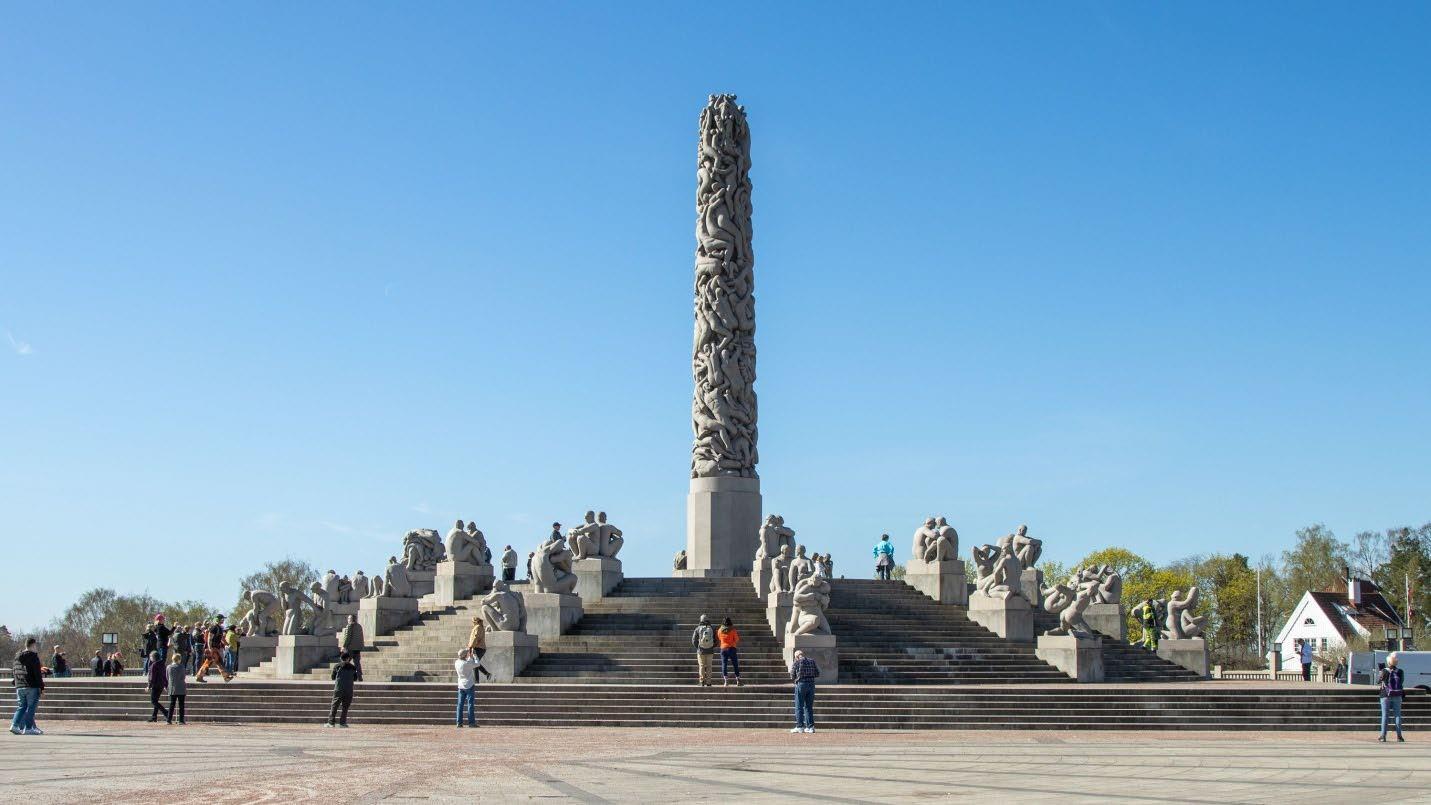
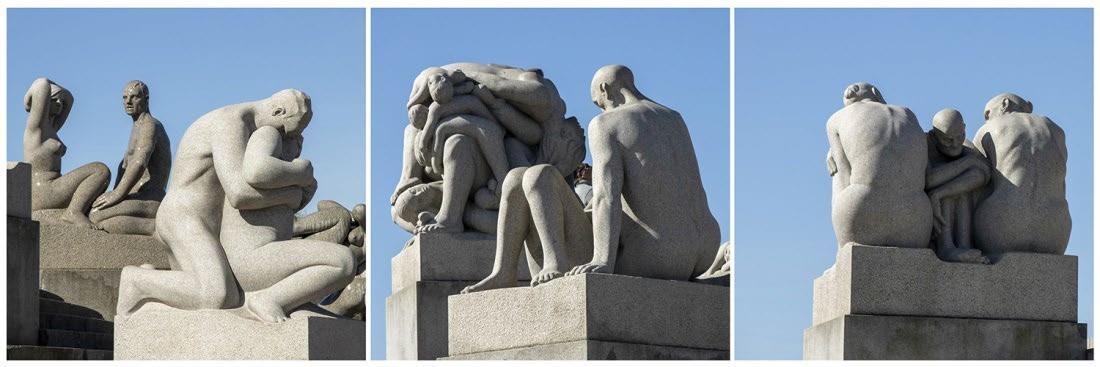
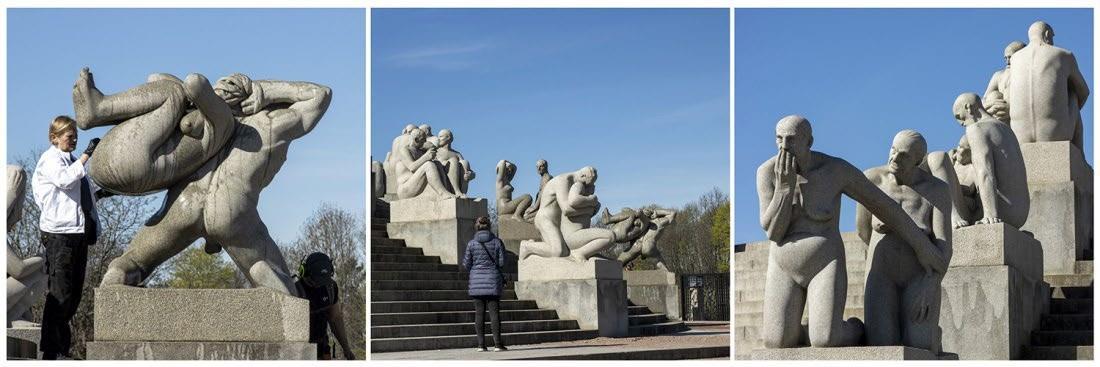
Of course, Oslo has many other sites of interest to anyone, but since we were in Oslo on previous occasions, we did not revisit them: the Munch Museum, the Akershus (ancient fortress for the city), the hall where the Nobel Peace Prize is awarded and the Royal Palace. We walked as much of the area near the harbor as our feet would carry us.




And we were taken up to Hohen-Hollen, the world-famous ski jump practice area and site of the Olympic ski jump competitions when the Games are held in Norway. The jump structure itself was terrifyingly high and we wondered how anyone ever gets up the nerve to ski down its steep slope the first time.
This little seaside village lies at the northernmost point of Denmark’s Jutland Peninsula. Though it is still an important herring fishing village, it is also noted for its long sandy beaches and its pristine dunes and picturesque moors. Thus, it attracts many tourists and summer seekers from all over Denmark and neighboring countries. The population in summer swells from 8000 residents to 50,000 with visitors counted.
The highlight of the visit for us was seeing and climbing the Rabjerg Mile, the largest migrating sand dune in Europe. The landscape is bleak; only a few grasses and plants grow on the sandy dunes. The sand is slippery but the slope to the top is not very steep. But the climb was challenging because it was two steps up and one sliding back down. The view from the top was expansive and encompassed more of the similar terrain. We could see the dry and bitten trees which were struggling to survive where the dune itself began to rise.

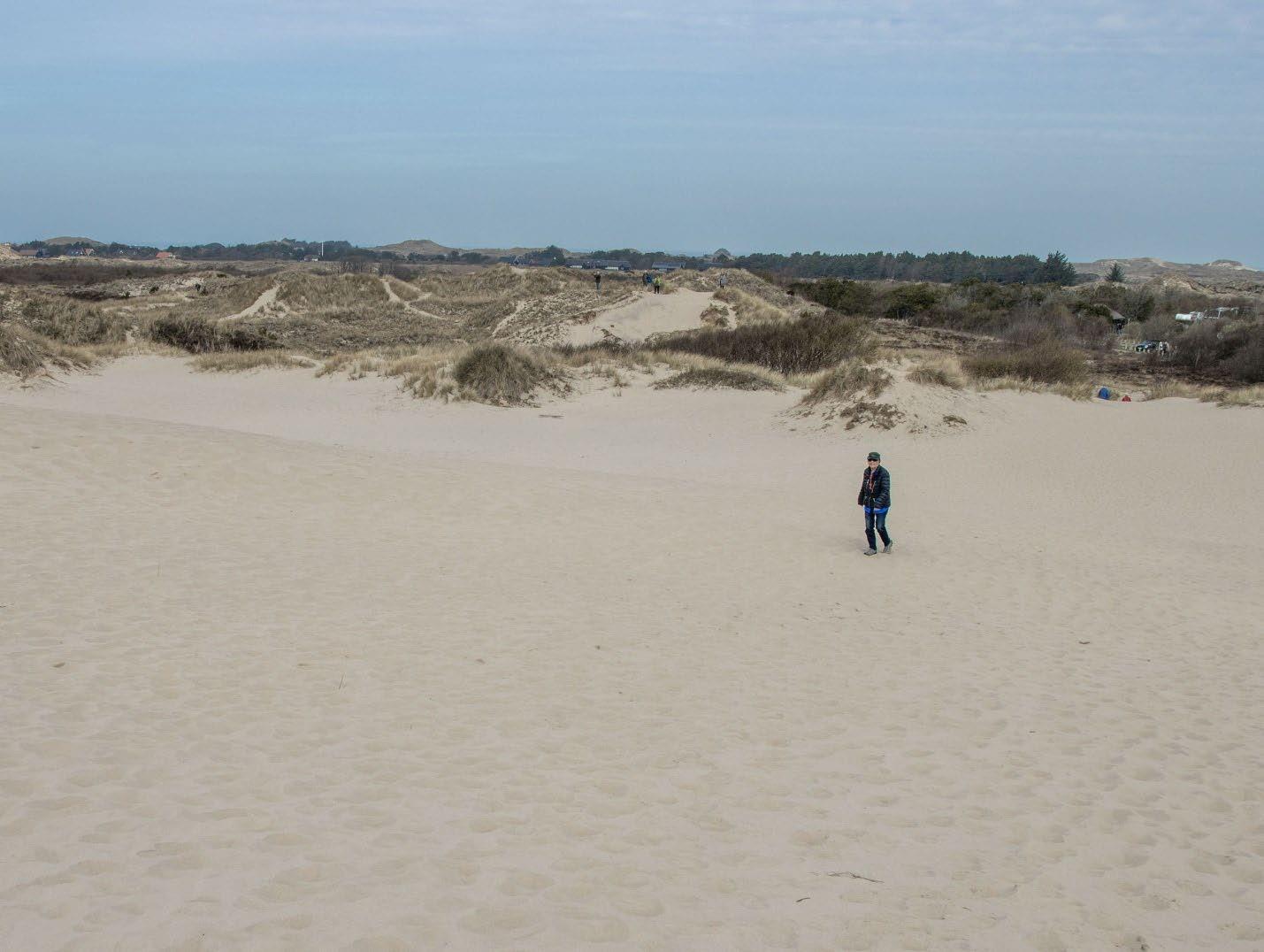
The sandy soil is useless for agriculture; there is not enough nutrition in the soil to grow much of anything. Therefore, the dune area is a designated natural preserve for the animals who can survive there; hares, fox and deer and a few birds are the only known creatures inhabiting the area.

We saw the last 43 meters of the tower for the 400year-old St. Laurence church which is still above the sand. Though the churchgoers tried to save the building from the constantly moving sands, they finally gave up the battle and let the sand engulf the rest of the structure. Today, the area surrounding the still useful tower (it warns ships of dangers near the Jutland Coast) is used for concerts, meetings and festivals.
It was also interesting to see the house where Karen Blixen (Isak Dinesen) wrote her wonderful novel “Out of Africa.”
1st Port: Amsterdam
Capital of the Netherlands. We were only here to transfer from the Viking Jupiter (ocean- going vessel) to the Viking Gersemi (river boat). The Gersemi is named for the Norse Goddess of Beauty.
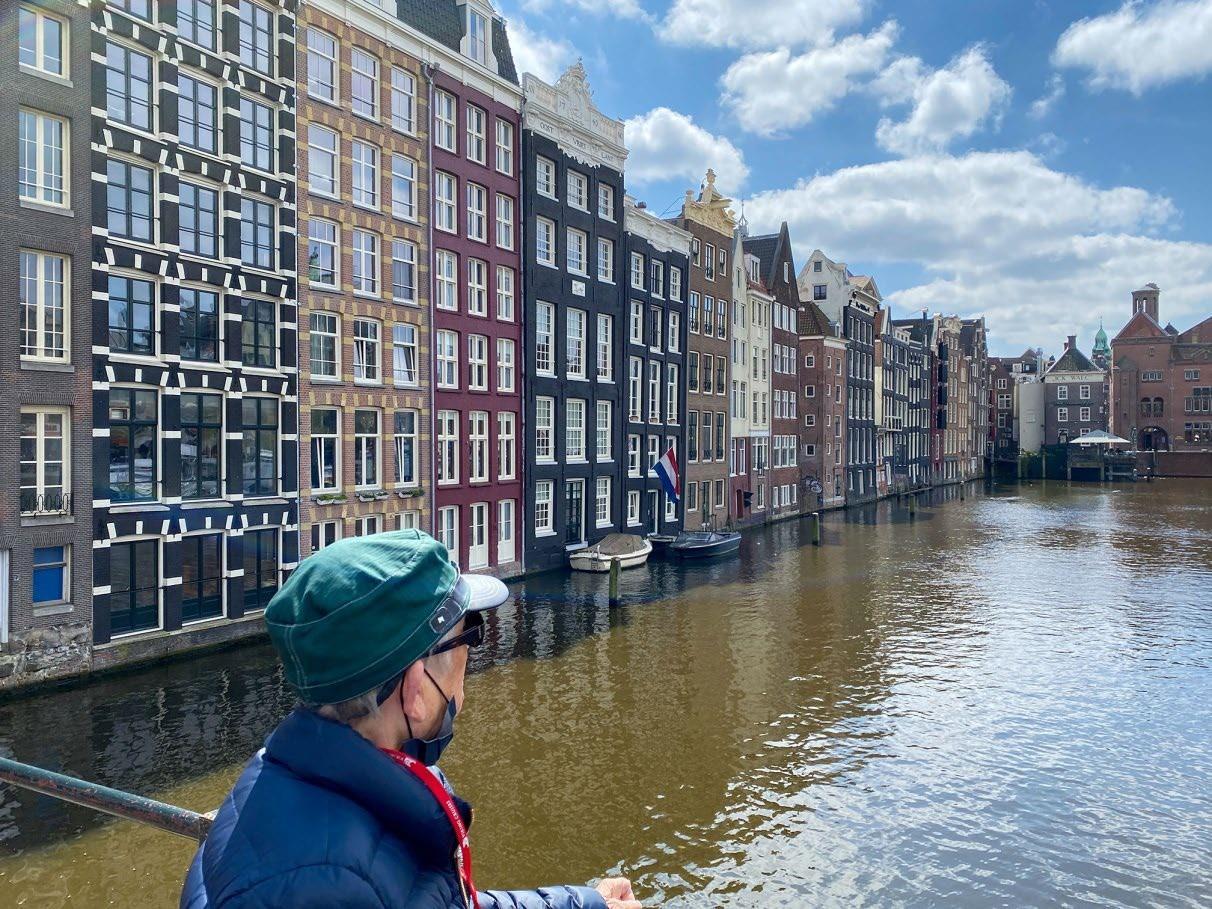
The transfer was smooth and created no problems. While we waited our time to board the Gersemi, a very brief tour of Amsterdam was offered and so we got off the ship and ventured out. Thank the travel gods that we have already been to Amsterdam on several occasions, so we were not disappointed over the tiny bit of this marvelous city we were shown: The Dam Platz, the big ornate Railroad Station, the exterior of a big church, now a museum, and the Red-Light District. It was cold and drizzly, so a short tour was a good thing.
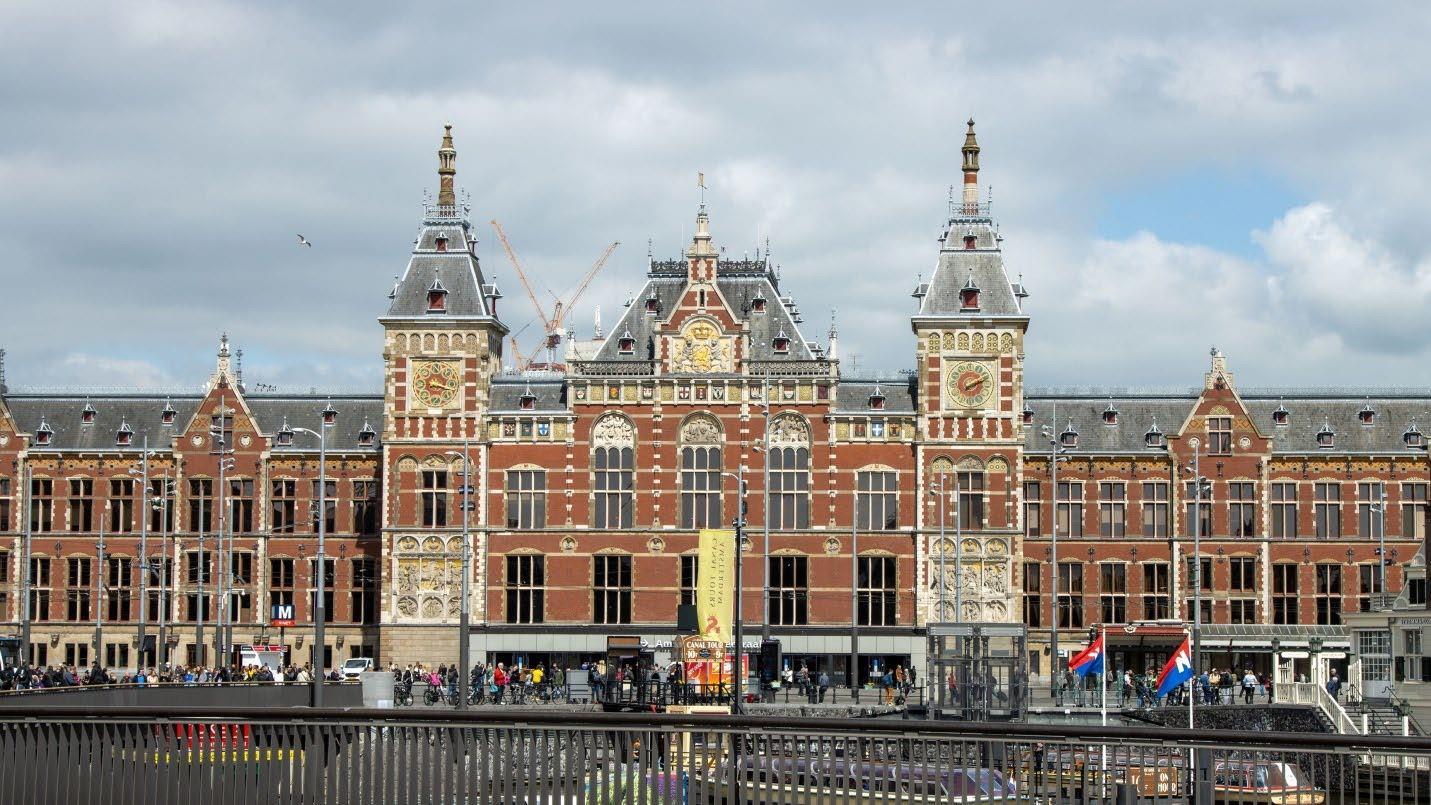
2nd Port: Kinderdijk
This is the famous row of windmills around which we rode bicycles when we were last here several years ago. On this occasion, we walked from the ship to the windmills and around a few of them. A knowledgeable guide accompanied us, explaining how the windmills help to control the water “enemy” of the Netherlands. Of course, the water is not only the foe of Dutch, but also a friend if its levels can be controlled. The guide explained that few of the old mills are still functioning, but most are maintained because this is a UNESCO site. The mills demonstrate the history of the ongoing war between the Netherlanders and the North Sea and all the ingenious ways the people have fought back.

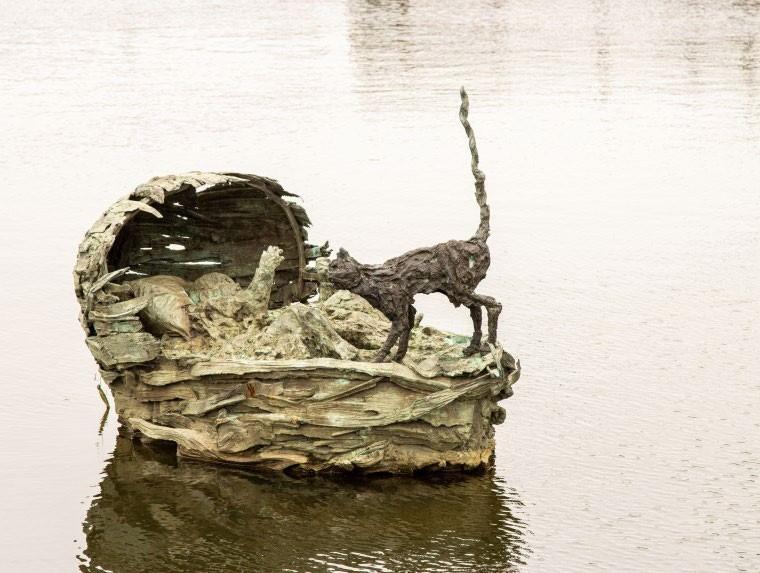
Something new to us there was seeing the statue of the Cat & the Cradle which memorializes an old story of a cat who saved a baby living in one of the windmills. Due to a windmill malfunction, water rose into the living area and threatened to drown the baby in her cradle. The cat leapt up on the cradle and kept it rocking which saved the child. We always like good stories about cats!
This is an ancient city with its roots in the Roman Empire. There are several ruins in the city that prove the Roman foundation, such as a large section of the old Roman sewage system which had to be removed when the city fathers determined it was past time to modernize the ancient infrastructure.
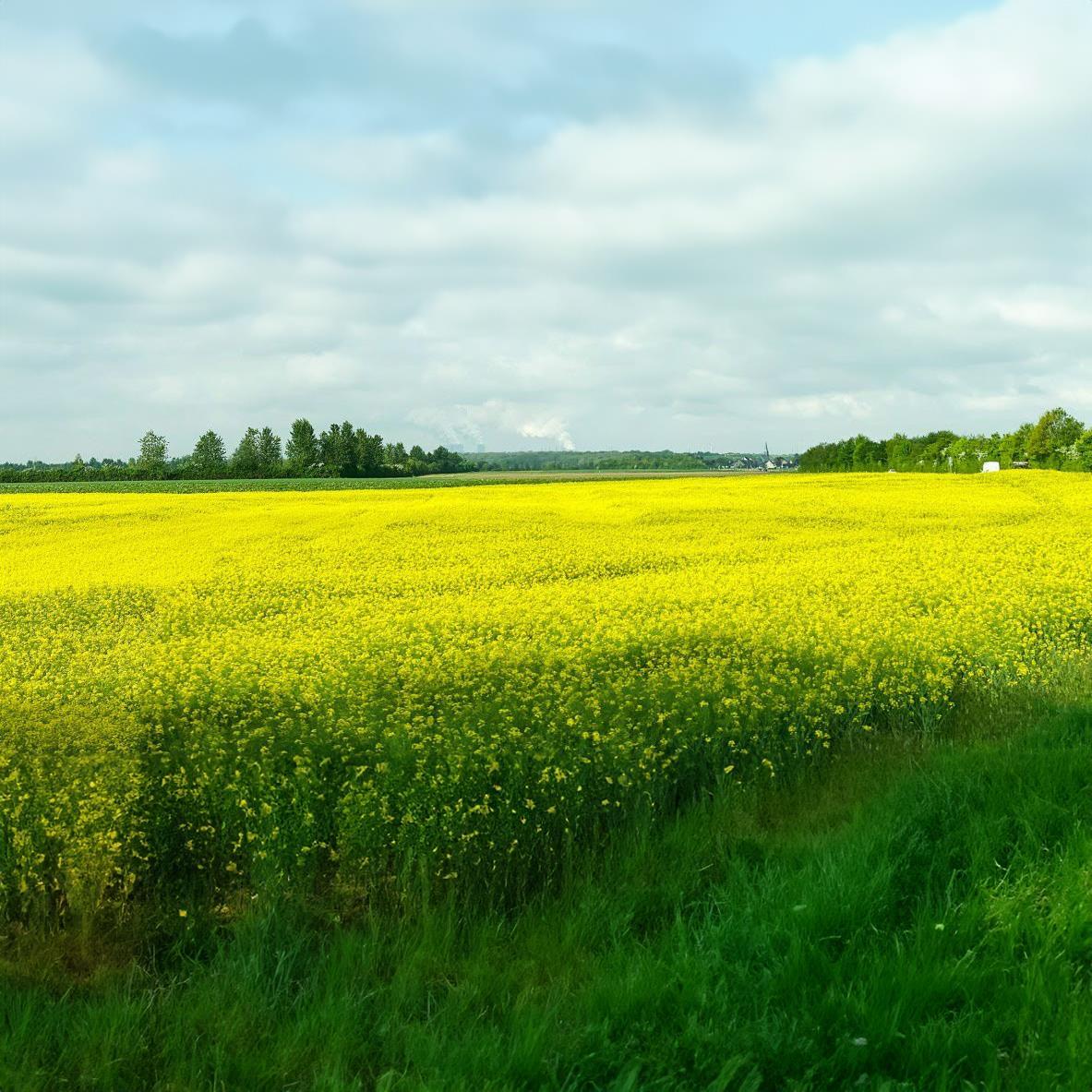
We enjoyed a 45-minute bus ride from the Gersemi into Cologne. The outskirts were rural with fertile fields, especially of the radiant golden rapeseed plants. Then, as we neared the city, the small clusters of tiny villages appeared. Brightly colored houses competed in the “color war” of trees, shrubs, fields, flowers and bright green lawns.


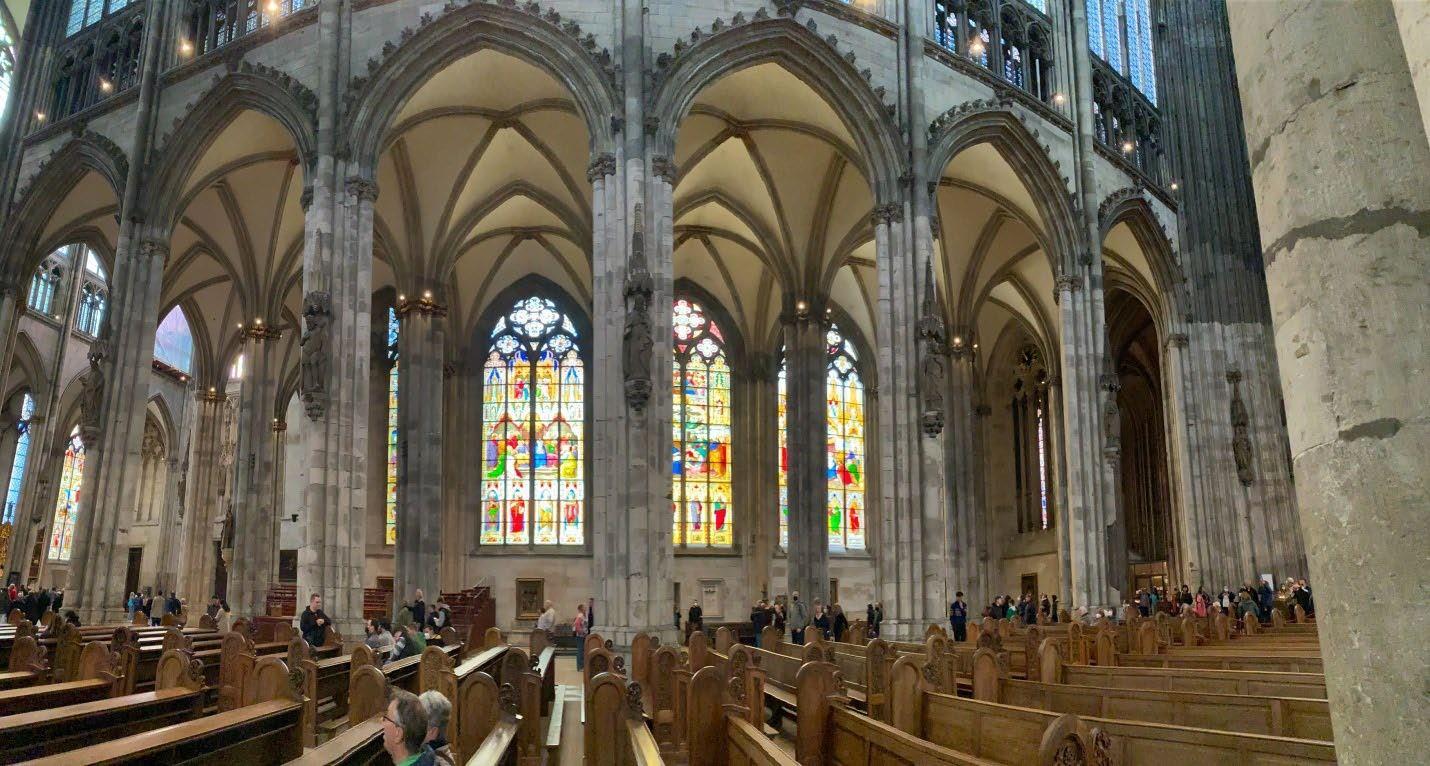
But the biggest draw in Cologne is its magnificent cathedral which was spared by the Allies in World War II.
The brilliant stain glass windows were removed to safety by the concerned populace prior to wholesale bombing missions started in that part of Germany. The cathedral is Gothic in design, and it was started in 1248 and construction continued over the ensuing seven centuries before being completed. Of course, the edifice is now a UNESCO heritage site. It is still the largest Gothic Cathedral in Northern Europe with its two soaring spires and its incredibly beautiful interior.
The brilliant stain glass windows are the most beautiful we have ever seen. As the sunlight pours into the structure, the windows become incandescent.
We could have spent at least a couple of hours in these sacred precincts but, alas, we had less than half an hour to appreciate this mighty work of man.
We were then shepherded out and into the old city with its cobblestone streets. There we saw two more church buildings, St. Martins and St. Anthony’s which were not strictly gothic but still towering and marvelous. The current Town Hall had been built to look like a church to prove that the inhabitants of Cologne were good Catholics during a time of religious conflict and uncertainty.
The afternoon tour took us to the Koln Castle of Clement Augustus, the Master of the Teutonic Knights, as well as the Bishop and Archbishop of several German territories. Of course, he ended up immensely wealthy and loved to spend his money on castles, hunting lodges, lavish parties, women, and constant upgrading of his many homes. He also built a small chapel on the grounds of the Hunting Lodge (for falconry) to Egyptian Mary, an obscure saint that he named in his official church position. We could not go into the chapel because it is considered too fragile. Overall, Clement Augustus did not seem a worthy person for a church leadership position.
Our excursion here was the absolute best of the entire trip. Why, you may ask?
Because of the talented and adorable re-enactor who was our guide at the formidable and beautifully constructed Ehrenbreitstein Fortress we visited above Koblenz. From its ramparts, we could view Koblenz and the confluence of the Rhine and Moselle Rivers as well as the Eifel Hills. The Fortress was built on the site of a previous fortress whose history went back to 1100. The setting in a lovely park today is thoroughly enjoyable.


The present citadel was built in the early 19th century to protect against the French. Pictures will reveal its handsome design and intricate stonework.We were met by a young German actor who transformed himself into Lieutenant John Humfrey of the British Corps of Engineers. Lt. Humfrey was there as a spy to learn the secrets of the structure, such as escape tunnels, cannon emplacements, vulnerable points of entry, locations of armaments and the like. Our young actor was dressed in what Lt. Humfrey would have worn and he managed a good English accent. We quickly realized we were in the play/drama with him as he enlisted us as fellow spies and aides. He never broke character, and he was genuinely funny. Usually, I am not enthusiastic about touring old forts anyway, but he made this visit a delight.
After completing our spy mission, we were loaded onto gondolas which carried us off the mountain and down into the town of Koblenz. What a fun way to see more of the city and the river confluences. Koblenz was founded more than 2000 years ago. The Teutonic Knights set up their first base here in 1216. The Romanesque Basilica of St. Castor is the oldest structure left in the city, dating from 836.
The city is charming with cobblestone streets, wood-beamed houses adorned with colorful flowers and its ancient Market Square. We enjoyed walking along the city streets and seeing the people at shops, outside cafes, and meandering as we were.
5th Port: Speyer, Germany

This German city is credited with giving us the word “Protestantism” in 1529 when local royalty and common citizens signed a “Protestation at Speyer” proclaiming their right to practice Christianity as they pleased. The largest Romanesque cathedral in the city is the burial site of 8 emperors including some of the Holy Roman Emperors. The Cathedral is now a UNESCO World Heritage site. Dedicated to Saint Castor, it was built between 836 and 1061.
Of course, it has been modified, repaired and enlarged during its long existence. Its towers are said to represent the seasons and the four corners of the world where Christianity reached.
Though the big cathedral was the main calling card for the city, our walks through the backstreets where people live were the most delightful. The houses are old and well-maintained, and porches and gardens sported lovely flowers and other decorative items. We enjoyed crossing the little river in the residential area using ancient bridges, some of which dated to Medieval times. It is called the Sonnebruge or Sun Bridge.

The Jewish convert to Christianity, Edith Stein, lived in Speyer for many years. She became a nun and served the city in many ways. She was martyred during the Holocaust despite her conversion to Christianity and she was later made a saint by the Roman Catholic Church.
6th Port: Strasbourg & Kehl
Strasbourg is a city which has changed countries on multiple occasions between Germany and France. Currently it is French but still shows traces of its Germanic periods as well. Several of the EU agencies are based here: the European Parliament, the Council of Europe, the European Court of Human Rights, the European Science Foundation, and the European Youth Center.
Perhaps because of all this “officialdom” the city is modern and blessed with convenient, efficient, and widespread infrastructure for transportation anywhere in the city. Many bridges cross the Rhine and Ill Rivers; there are trams, buses, bike paths, excellent roads, and clear signage for navigating through the city.
The Strasbourg Cathedral de Notre- Dame (Catholic) was the tallest building in the world from 1647 to 1874 because its single tower stood 142 Meters (466 feet). Today it is the 6th tallest church and the highest still standing extant structure entirely built in the Middle Ages. The church is sublimely beautiful, especially its gorgeous stain glass windows.
Little Kehl is the German city bordering Strasbourg. Our guide told us that it is much cheaper for Strasbourg residents to cross over into Kehl to do their shopping because prices on everything from food to clothing to furniture to appliances and many more things are much lower there.

And because both are EU cities, there is no barrier or checkpoint to navigate going from one city to the other.
Kay and I spent the afternoon in Kehl rather than in the larger city because we wanted to explore some local neighborhoods and see how the people are living.


The town may be smaller and less famous, but it is modern and prosperous as well. We quickly found a Catholic Church which was surprisingly open. It was dedicated to St. Nemo and was uncharacteristically spare in decorations. Such a change from the richly decorated and highly artistic Gothic and Romanesque Cathedrals we had become accustomed to seeing on this cruise.
On the city streets we walked by comfortable houses, many small but lovely parks with benches and fountains and people enjoying the outdoors on a warm and sunny day. We watched people playing with their dogs and children and picnicking on the grounds. We walked through wildflowers and soft green grasses, so inviting that day.
7th Port: Colmar and the Black Forest, Germany
Colmar is a small town, but it retains a charming vintage ambience. As we have seen before, the streets are cobblestone, and the buildings are dated even when they are decorated with colorful murals depicting bright flowers and happy people. Many half- timbered houses are saucily painted with humorous characters and funny words.

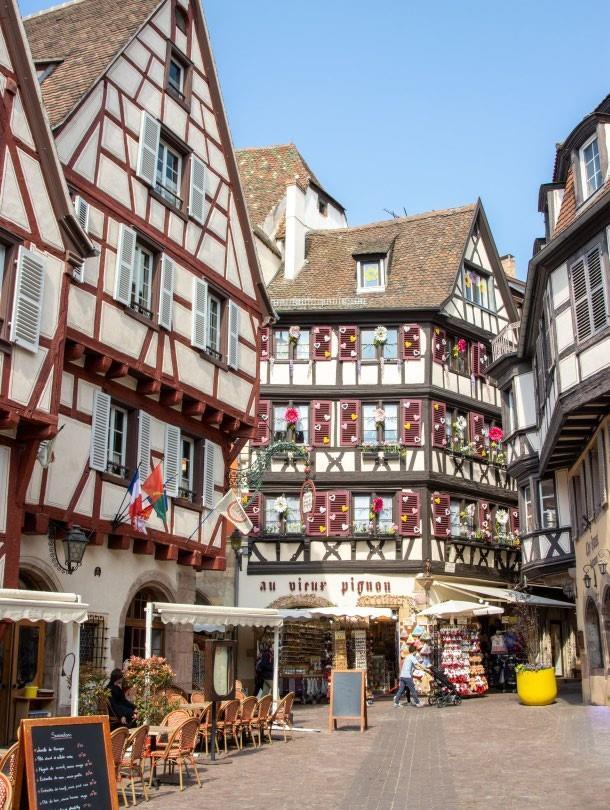

The cathedral was dark and closed while under construction and more Gothic than Rococo.
Many trees and shrubs give the town a rural feeling and bird song was heard everywhere. The famous European storks nest in numbers here and the townspeople are very welcoming and protective of these large birds. We saw many on nests and others carrying nesting materials to new nest sites.
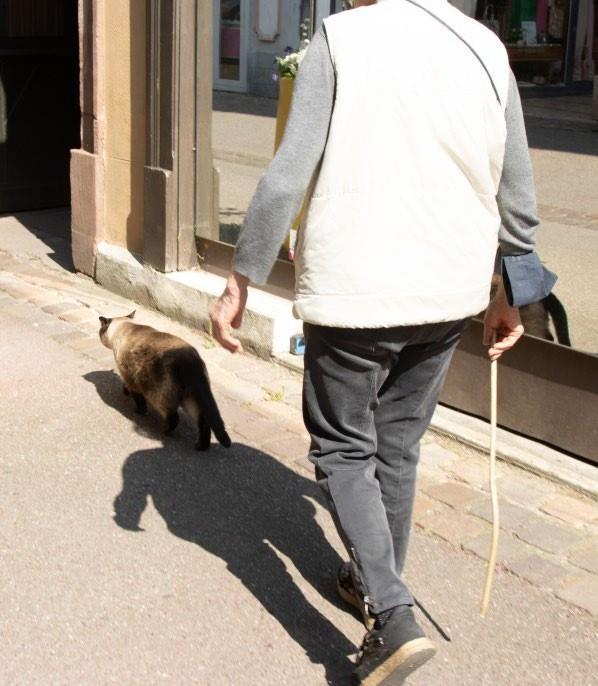
Speaking of animals, the residents are also fond of dogs. We encountered many strutting along happily leading their owners ever forward. The most curious encounter with pets was seeing a large grey cat being “herded” by his owner with a slender stick back into his own front yard behind a wooden gate. He had wandered out of his own territory when someone forgot to close the gate. The owner tapped him lightly to urge him in the right direction and he would give her a peeved look as he continued to move on. We waited until we saw him safely inside the colorful garden that is home.
In the afternoon, we left Colmar and took a long drive up into the storied Black Forest. The day had turned dark and cloudy and occasional spotty rain dappled the windows of the bus. The water curtain could not hide the beautiful scenery as we rose higher and higher into the mountains.

The forested areas were dark and mysterious. Farmlands were well tended and lovely with colorful crops or straight plowed fields awaiting seeding. Interspersed were white coverings which protected the famous black forest white asparagus from turning green the strawberries from too much sunlight.
When we reached 3000 ft. in altitude, we had reached a touristy area on a plateau named Hofgut Sternen. It reminded us of Helen, Georgia, a town which had transformed itself into a “black forest” hamlet to attract tourists. Its do-over really did bring the town back to prosperity. There were several buildings housing Cuckoo clocks and other trinkets made from wood expertly carved. We were supposed to get a demonstration on the making of these clocks, but that had been cancelled earlier in the year. There was also a glassblowing products shop and a demonstration had been promised there as well. But it had been cancelled earlier as well. There was a little café/eatery too, but it was not open either. We had signed on to do a guided hike, but the rains came down more steadily, so we opted out. When the rain turned to a sprinkle, we headed out for some walking on our own. It was an attractive pathway with a small, picturesque waterfall as a focal point. The Ravenna Bridge that carries trains was impressive. We are happy we saw the famed Black Forest, but rain and the touristy appearance of the little hamlet put a real damper on our visit.


Unhappily, the rains and chilly weather followed us up the Rhine all the way to Basel. We had decided on an extension of two days to visit this Swiss city which we had never seen before. Our guide was enthusiastic and interesting, and we enjoyed the walking tour of the city despite the rain which continued the whole time we were out in the streets. We had a shockingly expensive lunch after we left the tour group. We shared strange green pasta dish advertised as “spaghetti and a salad; and the bill was $45.00!
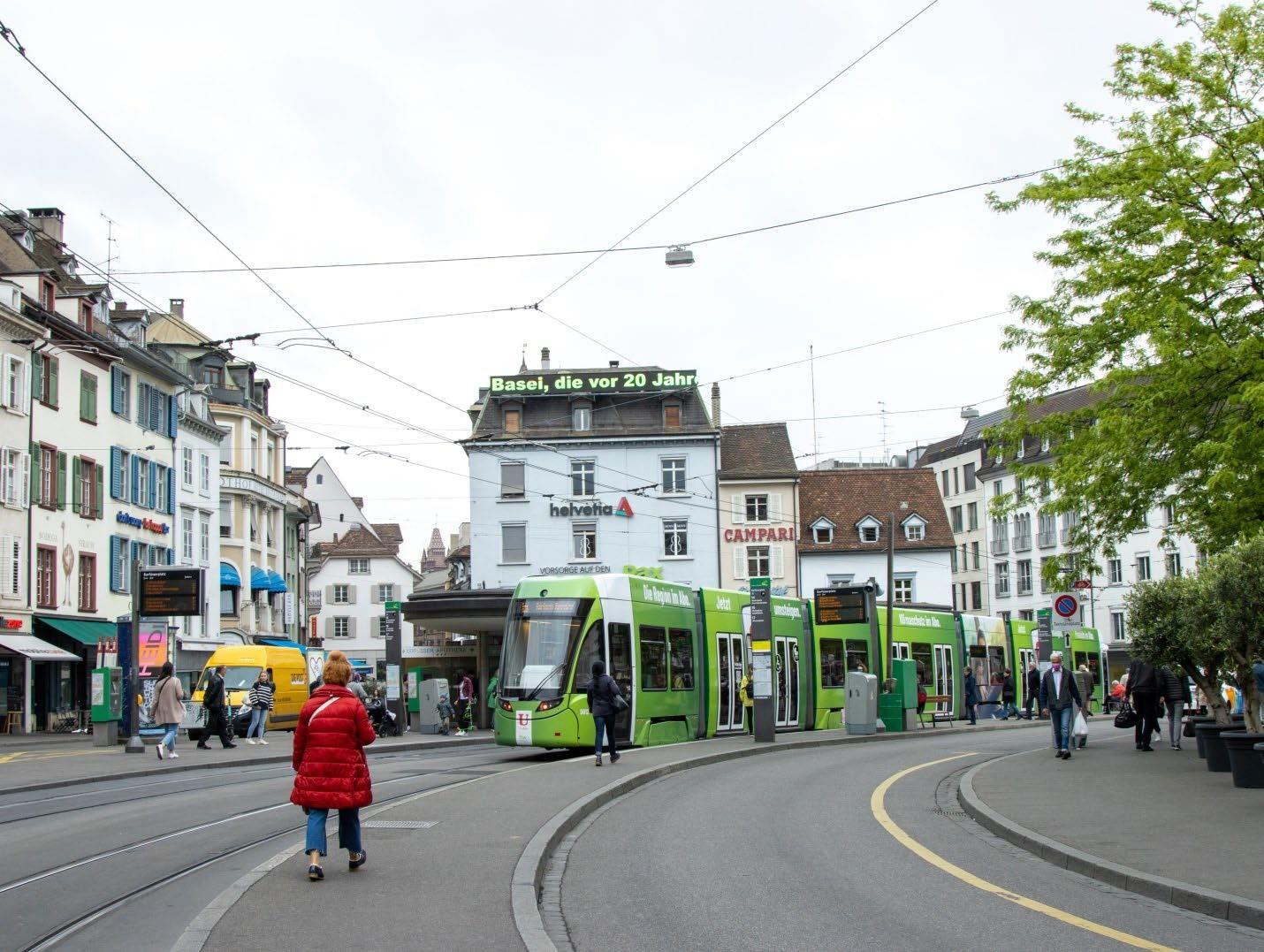
The Swiss are a passionately Protestant people. We learned that they had thrown out all the Catholics after the Reformation. Today, there is but one functioning Catholic church here in Basel.
The amusing Tinguely fountain entertained us for a few minutes in the rain. Quite cleaver.




On our second day in Basel, we arranged to take a private tour up to Lake Lucerne and the Alps. A nice couple we had not met before, joined us. Alas, the rain continued through the entire 2-hour drive to Lucerne. The sky was dark and threatening too so we had little hope of seeing the Alps. Hence, it was good that we were prepared to be disappointed. We bought tickets to ride in cable cars up to the top of Mt. Pilatus, hoping for some photogenic views of the Alps. But that did not happen either. The ragged but thick clouds followed up the slope and we could not even see the ground from our gondola. Mt. Pilatus is 7000 feet (about 2134 m) high, and it requires two different cable cars to reach the summit. At the summit, there are two big hotels and a large visitors center with a restaurant, shops and a movie showing details of the mountain and its history. The clouds were so thick we could nothing of the surrounding peaks nor of Lake Lucerne itself.
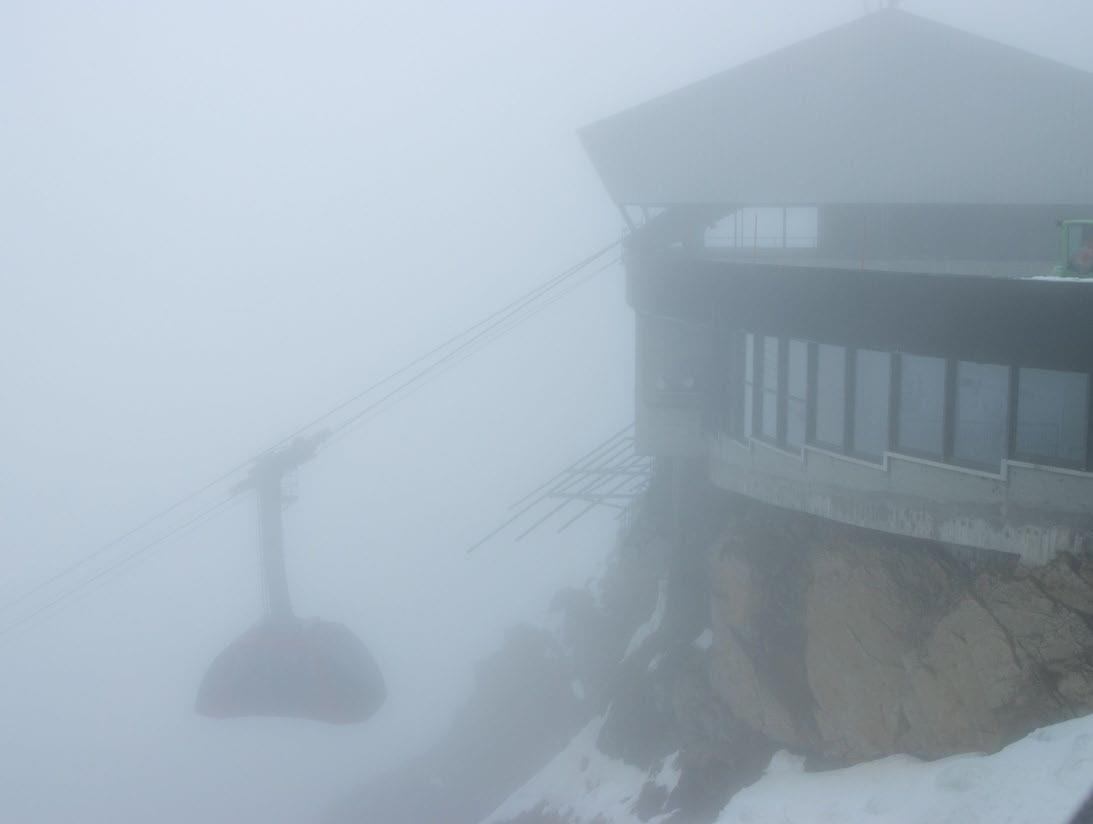
The most interesting and fun part of being atop Pilatus was watching the crows dancing and balancing on the bitter cold aluminum fencing around the large plaza in front of the Visitors center. An old gentleman was feeding the hungry and eager birds from his hands and on the plaza tiles. They jumped and flew, squabbled, and
ate everything he provided. They were very amusing and kept the trip up from being a total bust.
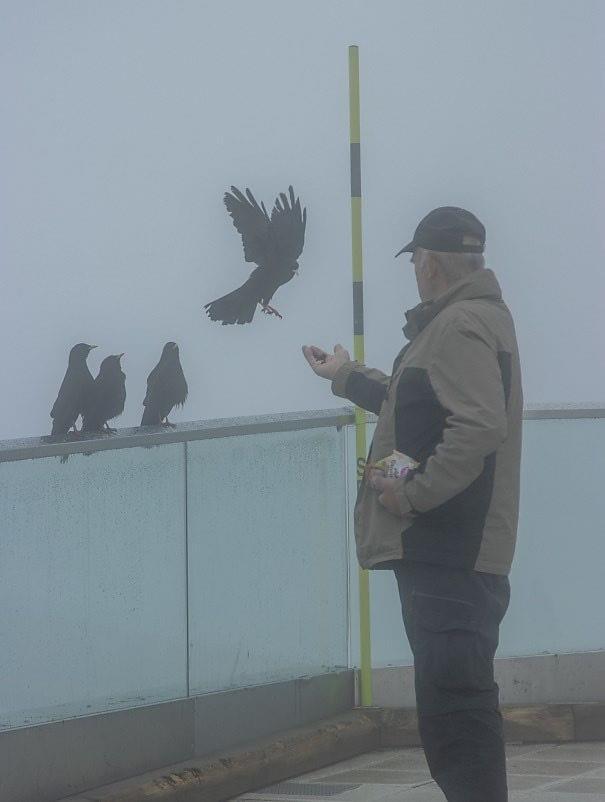
Luckily, the drive to the Lake had been beautiful with pretty farmlands, quaint houses, and gorgeous yellowgold rapeseed fields glowing and bravely trying to make up for the lack of sunshine. And the picturesque town of Lucerne was interesting: for Swiss Chocolates, lunch at Mr. Pickwicks Fish and Chips house, and a stroll over the 13th century wooden bridge which partially burned in 1993.

The structure was repaired and as much as possible of the paintings on the walls and lintels were restored. The bridge still reveals many of the charred places and some of the artwork is so black it is hard to determine what was being depicted.

Once across the bridge we found the Jesuit Church, a Romanesque designed facility which took only 10 years to erect in the 17th Century. An unbelievably short span of time for such a large and ornate church. It was quite beautiful inside with much gold and elegantly carved wooden pews, pulpit, and choir area.


To close out our rainy day in Lucerne our driver/guide took us next to see the Lion Memorial to the Swiss Guardsmen killed defending the French King (Louis the 14th) during the French Revolution.


More than a 1000 Guardsman died in battle or were later guillotined when caught or perished of wounds while in prison. The monument is hewn from the living rock of a granite cliff. It was designed by Bertel Thorvaldsen and carved by Lukas Ahorn. It depicts a colossal lion lying on his side in his lair, dying due to the spear piercing his shoulder. The animal is noble and dignified in death. Mark Twain called it “the most mournful and moving piece of stone in the world.” Indeed, a grave but beautiful ending to our time in Lucerne.
Besides visiting the many towns along the river, the other attraction is seeing and photographing the many storied castles perched on the cliffs and hillsides of the river. Most of them are in the Middle Rhine. During our passage through this beautiful section of the river, we were most often on the top deck listening to the guide point out the individual palaces and points of interest. Since it was quite cold in the wind, the ship personnel thoughtfully provided us with blankets and towels to wrap ourselves. We were also given a map which pinpointed the individual castles for us. Unfortunately, that map did not make it home with us and I cannot remember the names of all the ones we saw.
The structure we were most interested in seeing is the “Mouse Tower.” In Kay’s book “Winters Wrath” that tower plays a significant role in the story. Whether the old tale about the corrupt clergyman who tried to hide in the tower but was killed and eaten by mice is true or not, we were so happy to see the tower that is very real indeed.
The other fascinating thing about cruising along the Rhine is learning about the difficulties in navigating it. Locks are necessary in many places and great variations in water levels along the course create real problems for ship captains and anyone using the waterway. Besides the locks, they are also other physical structures, like dams & reservoirs which help maintain constant water levels. From Amsterdam to Basel, ships are constantly going upstream against the current which is quite strong in many places. This creates navigational problems in addition to the many places where rocky shores and jutting natural stone barrier are present. Navigating the Rhine requires formal and extensive training and considerable experience before a student can receive his credentials.
Much of the river is flanked by cliffs, forests, and farmlands. There are a few “beaches” where people can drive RVs and camping vehicles to spend some time on the Rhine, but most areas are too steep and rocky for such activities. Many times, we felt like we were floating through a tree-lined and narrow hallway. However, that is not to say that cruising on the Rhine is not thoroughly enjoyable. On a Viking river boat, you can totally relax, feeling pampered and well-fed, and immerse yourself in a beautiful part of the world.